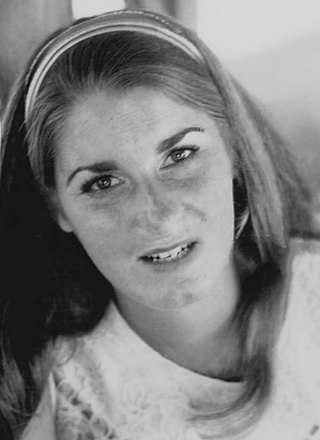
Julie Heldman is an American tennis player who won 22 singles titles. In 1969 and 1974, she was ranked as the world No. 5. In 1968 and 1969, she was ranked No. 2 in the U.S. She was Canadian National 18 and Under Singles Champion at age 12, U.S. Champion in Girls’ 15 Singles and Girls’ 18 Singles, Italian Open Singles Champion, Canadian Singles and Doubles Champion, and U.S. Clay Court Doubles Champion. She won three medals at the 1968 Mexico City Olympics, and three gold medals at the 1969 Maccabiah Games.
Gladys Medalie Heldman was an American tennis player, manager and magazine publisher. She was the founder of World Tennis magazine. As a manager, she supported and represented Billie Jean King and eight other female tennis players: Rosie Casals, Judy Dalton, Julie Heldman, Kerry Melville, Peaches Bartkowicz, Kristy Pigeon, Nancy Richey, and Valerie Ziegenfuss. They were called the Houston Nine and formed the Virginia Slims Tour in the early 1970s. She is a member of the International Tennis Hall of Fame and the International Jewish Sports Hall of Fame.
The Virginia Slims Circuit was a tennis tour consisting of a group of originally nine female professional players. Formed in 1970, the Virginia Slims Circuit eventually became the basis for the later WTA Tour. The players, dubbed the Original 9, rebelled against the United States Lawn Tennis Association (USLTA) because of the wide inequality between the amount of prize money paid to male tennis players and to female tennis players.

Valerie Bradshaw is an American former female professional tennis player. She started as an amateur player at the beginning of the 1970s, then turned professional.
The Original 9 were a group of nine women's professional tennis players who broke away from the governing bodies of tennis in 1970 to launch their own professional tour, the Virginia Slims Circuit, which later evolved into the modern WTA Tour.
The 1970 Houston Women's Invitation was a women's only tennis tournament. The tournament was the first women only tournament and was created by Gladys Heldman and held at the Houston Racquet Club.
Vladimir Viktorovich Korotkov is a retired Soviet tennis player who won three Junior Grand Slam tournaments, Wimbledon Juniors in 1964, 1965 and French Juniors in 1965. He also won the mixed doubles at the 1968 Summer Olympics where tennis was a "demonstration sport". He won the men's doubles event at the 1973 Summer Universiade and the 1977 USSR singles championship. Since 1981 and until his retirement in 1996, Korotkov was coaching at several sports clubs.
Rosa María "Rosie" Reyes Darmon is a retired tennis player from Mexico who was active in the 1950s and 1960s.
Zaiga Jansone-Ivanova is a former Soviet Latvian tennis player and tennis coach. She was a five-time Soviet champion in women's doubles, 1973 Summer Universiade champion in women's doubles and winner of the exhibition tennis event of 1968 Olympics in mixed doubles.

Battle of the Sexes is a 2017 biographical sports film directed by Valerie Faris and Jonathan Dayton and written by Simon Beaufoy. The plot is loosely based on the 1973 tennis match between Billie Jean King and Bobby Riggs. The film stars Emma Stone and Steve Carell as King and Riggs, leading an ensemble cast including Andrea Riseborough, Elisabeth Shue, Austin Stowell, Bill Pullman, Natalie Morales, Eric Christian Olsen, and Sarah Silverman in supporting roles. The film marks the second collaboration between Carell and Stone after Crazy, Stupid, Love and the second collaboration between Riseborough and Stone after Birdman.
The women's doubles tournament at the 1969 French Open was held from 26 May to 8 June 1969 on the outdoor clay courts at the Stade Roland Garros in Paris, France. The third-seeded team of Françoise Dürr and Ann Jones won the title, defeating the first-seeded pair of Margaret Court and Nancy Richey in the final in three sets.
Since the 1968 Summer Olympics did not feature tennis as an official sport, two unofficial tournaments were held during the Games: a Demonstration tournament and an Exhibition tournament.
Since the 1968 Summer Olympics did not feature tennis as an official sport, two unofficial tournaments were held during the Games: a Demonstration tournament and an Exhibition tournament.
Since the 1968 Summer Olympics did not feature tennis as an official sport, two unofficial tournaments were held during the Games: a Demonstration tournament and an Exhibition tournament.
Since the 1968 Summer Olympics did not feature tennis as an official sport, two unofficial tournaments were held during the Games: a Demonstration tournament and an Exhibition tournament.
Since the 1968 Summer Olympics did not feature tennis as an official sport, two unofficial tournaments were held during the Games: a Demonstration tournament and an Exhibition tournament.
Since the 1968 Summer Olympics did not feature tennis as an official sport, two unofficial tournaments were held during the Games: a Demonstration tournament and an Exhibition tournament.
Since the 1968 Summer Olympics did not feature tennis as an official sport, two unofficial tournaments were held during the Games: a Demonstration tournament and an Exhibition tournament.
Since the 1968 Summer Olympics did not feature tennis as an official sport, two unofficial tournaments were held during the Games: a Demonstration tournament and an Exhibition tournament.
Since the 1968 Summer Olympics did not feature tennis as an official sport, two unofficial tournaments were held during the Games: a Demonstration tournament and an Exhibition tournament.


